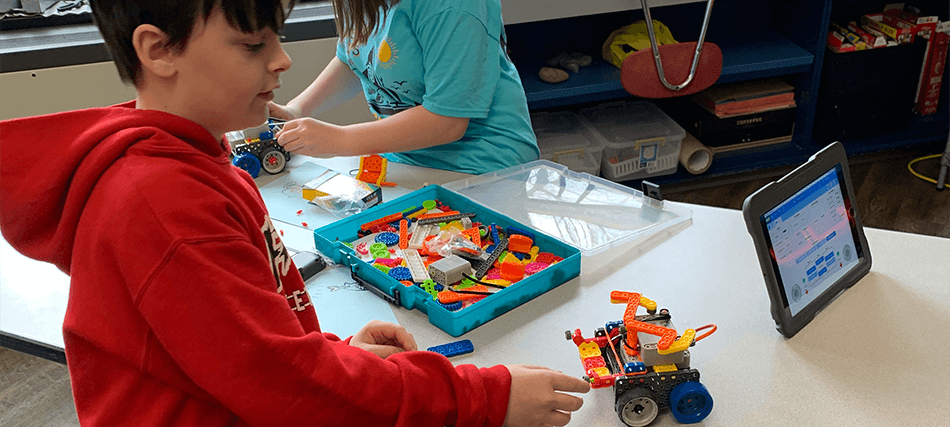A New Way to Define “Defining the Problem”
There is little doubt that providing students with complex, open-ended challenges, such as those included in STEM Labs across the VEX Continuum, is essential for helping students to build their creative problem solving skills. Using the engineering design process to organize and structure students’ problem solving efforts is equally uncontroversial. However, it may be surprising to consider how much creativity can be encouraged and developed in students through careful and considered implementation of the Define the Problem stage of the engineering design process.
It is tempting to look at the Define the Problem stage as fairly simple and straightforward, and to move through it quickly to get to the assumedly meatier Develop Solutions stage of the process. However, viewing Define the Problem in a simplistic way can be a huge missed opportunity for promoting creativity in your students. Guiding students to identify multiple possible approaches to solving a problem can open up creative potential and help them to become more effective problem solvers in and out of the classroom.
In competition STEM Labs, such as VEX IQ (2nd generation) and VEX EXP, students apply the engineering design process as they engage in iterative problem solving in order to develop the best possible approach to the Unit competition. Students begin the process by defining the problem they are trying to solve – scoring the most points in the competition. On the surface, this involves things like understanding the scoring and game rules associated with the competition, and considering the best robot design for a chosen game strategy. Thinking more deeply…

A Framework for Defining the Problem
In Ronald Beghetto’s book, What If? Building Students’ Problem-Solving Skills Through Complex Challenges, he identifies four action principles that can be used to help students respond to the uncertainties of open-ended challenges: Stop – Think – Do – Learn1. The first two principles, Stop and Think, align with Define the Problem in the engineering design process. When applied, these two action principles can help learners engage in new ways of thinking about a problem, embracing possibility thinking, and ultimately, generating more robust solutions to challenges.
Stop
When students Stop to take time to deeply consider the problem or challenge they are facing, they are exploring and preparing to solve the problem. Students should consider what they already know about the problem, and what they still need to find out. Providing students with a checklist to help frame their exploring and preparing is highly beneficial as they develop their problem solving skills. The checklist below could be used for students engaged in preparing for the Competition Lesson in a competition STEM Lab.
Exploring and preparing checklist:
Think
Once students have stopped and examined the problem, in this case a STEM Lab Classroom Competition, they can then move on to Think about possible solutions. Students need to think both divergently – to generate multiple strategy possibilities, and convergently – to determine which of the possibilities are most likely to provide a winning overall strategy2
Beghetto suggests encouraging students to ask “What If” questions as a way to prompt students to come up with many creative ways to approach solving the same problem3. When brainstorming these ideas, everything should be on the table! This is not the time to decide whether an idea is too far-fetched or silly. A checklist for using divergent thinking to generate multiple ideas for solving the problem of an IQ Classroom Competition could look like this one:
Divergent thinking for solving a the challenge of a Classroom Competition
After students have suggested multiple ideas for approaching the problem or challenge, they should take the time to consider all of the ideas they generated, and then use convergent thinking to narrow them down into the best ones to try. The checklist below is one example of questions that can be used to guide students’ convergent thinking:
Convergent thinking for selecting the best possible strategy ideas for a Classroom Competition
Barghetto’s Stop and Think action steps, as applied to the Define the Problem stage of the engineering design process, align beautifully with supporting students' creativity through collaborative problem solving as well. In order to collectively come up with multiple ideas for solving problems, students must provide feedback to other group members and find ways of combining multiple ideas into the best strategies to try in the competition.

Even though the examples in this article refer to IQ and EXP STEM Labs, Barghetto’s action principles can be applied to defining the problem in all kinds of open-ended problems, both in school and in life. The questions in the checklists can be modified to meet the needs of younger students. They can be used as facilitation questions as students are working, and can be used to model creative problem solving during whole class demonstrations as well.
The Define the Problem stage of the engineering design process is not just a beginning step to quickly rush through on the way to finding solutions. Rather, it is a critical stage that fosters a mindset of possibility thinking and encourages creative problem solving. Encouraging students to slow down and thoroughly consider the problem they are solving helps them to develop the skills needed to generate multiple ideas and evaluate them effectively. Next time you are guiding your students through a STEM Lab challenge, remember the power of the Define the Problem stage and use it to help your students’ creativity grow.
Have strategies to share about building creativity through the engineering design process? In the PD+ Community, or sign up for a 1-on-1 Session to talk with a VEX expert about developing your students’ creativity.
